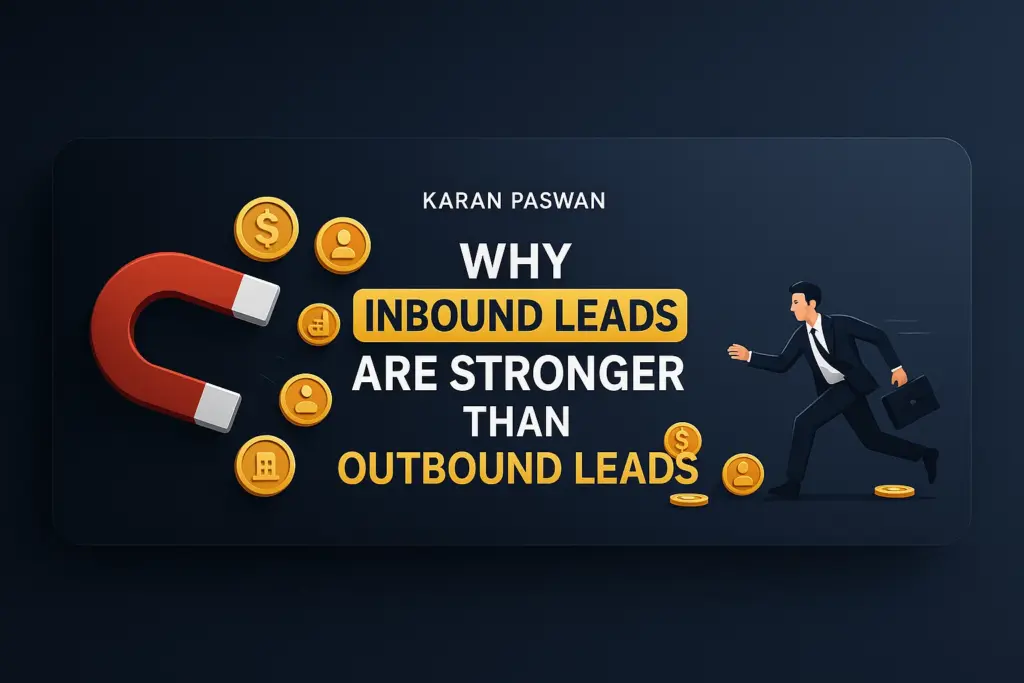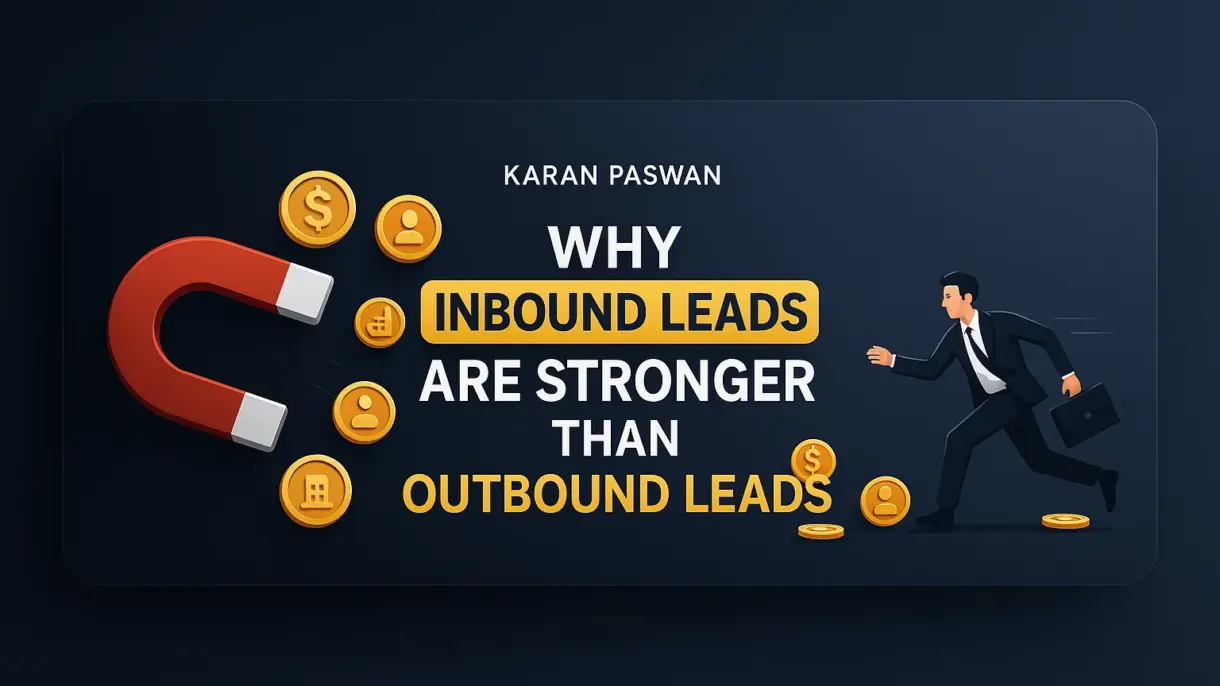
If you’ve been in business for more than five years, you’ve probably felt the difference between these two types of leads:
- Outbound Leads: You reach out to them.
- Inbound Leads: They reach out to you.
And if you’ve been in business long enough, you’ve probably realized: Inbound leads almost always close faster, stay longer, and cost less in the long run.
Today, I’m going to break down:
- Why inbound leads are so much stronger than outbound
- Where most businesses go wrong when trying to get them
- My proven inbound lead generation playbook for 2025
Let’s dive in.
1. Outbound vs. Inbound — The Real Difference
Outbound leads are people you chase. Cold calls, cold emails, DMs, direct mail, trade shows — you’re initiating the conversation.
The problem? They didn’t ask for your message. They didn’t ask for your pitch. They might not even have a problem you can solve right now.
You can still make sales this way (I’m not anti-outbound), but the mental game is tougher:
- You need more follow-ups.
- You face more objections.
- You fight for attention in a crowded inbox or feed.
Inbound leads, on the other hand, are people who already know they need something — and they’ve found you. They’ve searched on Google, read your content, seen your video, or been referred by someone they trust.
The difference is massive:
- Higher intent: They’re actively looking for a solution.
- Shorter sales cycle: Many are ready to buy now.
- Lower resistance: They’ve already “pre-qualified” you in their mind before they reach out.
In other words: Inbound leads are not strangers you have to convince. They’re motivated buyers looking for the right partner.
2. Why Inbound Leads Close at a Higher Rate
Let’s look at the psychology behind why inbound beats outbound for most businesses.
A. They’ve already identified their pain point
Outbound: You have to spend time convincing them they even have a problem. Inbound: They’re already Googling “best dentist near me” or “accounting software for small businesses.” The problem is real and urgent in their mind.
B. They trust you more from the start
Think about it — if they found you via an article, video, referral, or social proof, they’ve seen value from you before you even talk. Trust is already building before your first conversation.
C. You’re not interrupting them
Outbound interrupts people. Inbound invites them. When someone fills out your form, downloads your guide, or books a call from your website, they’ve taken the first step. That shift in dynamics changes the entire tone of the conversation.
D. It’s a better use of your team’s time
With outbound, you might have to sift through 100 contacts to find 2-3 potential buyers. With inbound, 8 out of 10 people who book a call with you are already in the buying cycle.
Bottom line: Inbound leads are like people walking into your store ready to shop. Outbound leads are like knocking on random doors hoping someone is home.
3. The Big Mistake Businesses Make with Inbound Leads
Here’s the catch: Many businesses think posting on social media or running ads automatically equals inbound.
It doesn’t.
Inbound lead generation is a system — not a random mix of content and hope.
The mistake I see all the time:
- No clear offer
- No strong call-to-action
- No system to capture the lead the moment they’re interested
Without a system, inbound becomes just “marketing noise.”
4. How to Build a High-Quality Inbound Lead Machine
Inbound lead generation is simple — but not easy. Here’s the 5-step framework I use with clients to get a consistent stream of high-intent leads.
Step 1: Clarify Your Offer (Before Anything Else)
You can’t attract quality inbound leads with a vague offer. If your website says “We do web design, SEO, social media, branding, and digital strategy,” you’ve given people no reason to choose you over the other 1,000 agencies they can find online.
Your offer should:
- Speak directly to your ideal customer’s biggest pain point
- Promise a clear outcome
- Show why you’re different
Example: Bad: “We help businesses grow with marketing services.” Good: “We help eCommerce brands scale from $50k to $500k/month with profit-first paid ads.”
Step 2: Be Where Your Audience Is Searching
Inbound leads can’t find you if you’re hiding. Focus on visibility channels where your ideal customers are actively looking:
- Google Search Ads & SEO: For high-intent keywords like “best tax accountant in Austin” or “buy ergonomic office chair.”
- YouTube: Educational content solves problems and builds trust.
- LinkedIn: Authority posts + clear CTAs for B2B leads.
Your goal is to be the obvious choice when they search for solutions.
Step 3: Use a Lead Magnet That Solves a Micro-Problem
Instead of asking strangers to “book a call” right away, offer them something valuable first in exchange for their contact info.
Examples:
- Free audit (“Get a free 5-minute website conversion review”)
- Short guide (“7 Costly Mistakes to Avoid When Selling Your Home”)
- Calculator or tool (“Find out how much your company is overpaying in software costs”)
Key rule: The lead magnet should solve a small but urgent problem related to your main service.
Step 4: Build a Conversion-Ready Landing Page
Your landing page is the bridge between attention and action.
It should have:
- A headline that clearly promises a result
- Social proof (reviews, case studies, logos)
- A simple, fast lead capture form
- One main CTA (not five different options)
Remember: Inbound leads are already warm — don’t make them work hard to contact you.
Step 5: Automate the Follow-Up
The biggest leak in inbound lead systems? Slow follow-up.
Research shows that if you contact a lead within 5 minutes, you’re 9x more likely to qualify them than if you wait 30 minutes.
Use automation tools:
- Instant email confirmation
- SMS notification to your sales team
- Auto-scheduling links to book calls without back-and-forth
Speed matters. Interest fades quickly.
5. Real Example: Turning SEO Into a 24/7 Lead Source
A home renovation company I worked with relied heavily on outbound — cold calling old lists, dropping flyers, and buying leads from directories.
We shifted them to inbound by:
- Creating a high-value guide: “The 5 Most Expensive Kitchen Renovation Mistakes (and How to Avoid Them)”
- Running Google Search Ads targeting “kitchen renovation contractors near me”
- Building a simple landing page offering the guide in exchange for contact info
- Automating follow-up with a 3-email sequence + call from their sales team within 10 minutes
Result? Within 3 months, inbound leads made up 65% of their pipeline, closing 2-3x faster than outbound.
6. The Long-Term Power of Inbound
Outbound is like renting a billboard. When you stop paying, the traffic stops.
Inbound — done right — is like buying property in the busiest part of town. It compounds:
- Content keeps ranking
- Videos keep getting views
- Your brand keeps getting referrals
Inbound is slower to build but harder to kill.
The Big Takeaway
Inbound leads aren’t just better quality — they’re more sustainable.
They:
- Come to you with intent
- Trust you before you talk
- Close faster and for higher value
- Build a business that’s less dependent on constant outbound hustle
If you want to stop chasing and start attracting, the formula is simple: Be findable. Be valuable. Be ready.
And remember — inbound doesn’t replace outbound. But if you want to grow with less friction and more trust, inbound is your foundation.
Your turn: What’s your #1 inbound lead source right now? And what’s stopping you from doubling it?

